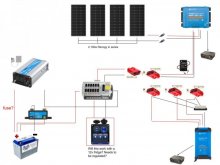timsim
New Member
- Joined
- Mar 29, 2021
- Messages
- 5
Hello! I'm very new to DIY solar power and battery stuff but I'm interested in building my own milk crate "solar generator", similar to the build Will did in his milk crate 2.0 video. My primary goal is to have serviceable, reliable, and portable backup power for power outages and camping. I'm envisioning building a few over time, and I have a few questions about what I have in mind for my first build. I've attached a bad diagram. But the tl;dr plan is:

1. Is a 1200W inverter good to connect to a 12v battery with max continuous 100a discharge without a fuse? Presumably the battery and the inverter both have overcurrent protection via the BMS and fuses, respectively.
2. Is a 1200w inverter the largest I could reasonably expect to power with a 12v battery with 100a discharge? 12v * 100a = 1200w continuously, is that how the math works?
3. Is my plan to decouple the MPPT charger and AC charger a wild thing to do? Is there something inherently unsafe about what I'm proposing there? Both of them charge at 30a, so I'm assuming I can use the same connector and swap them out, is that valid?
4. If I have the anderson connector coming out of the milk create hooked up to a 35a fuse in the fuse box, do I need any other fuses/circuit breakers between that and the MPPT charger/AC chargers?
5. If I get one of these 12v rocker switch panel things, how can I ensure the 12v outlet is going to run something like a 12v fridge? Is it regulated somehow? Is there something I should be buying instead if I'm interested in running something like that? Or should I just use my inverter?
6. Is anything I've wired here dumb or dangerous?
Parts (I've purchased nothing):
Battery - 12v 100ah Battleborn, SOK, or Amperetime or some such
Inverter - 1200w Giandel https://www.amazon.com/Inverter-1200Watt-Control-Outlets-Emergency/dp/B07G36Z2TH
Smart Shunt - Victron https://www.amazon.com/Victron-SmartShunt-500AMP-Bluetooth-Battery/dp/B0856PHNLX
AC Charger - (12v/30a/3 outputs) https://www.victronenergy.com/chargers/blue-smart-ip22-charger
MPPT Charger - (100/30) https://www.victronenergy.com/solar-charge-controllers/smartsolar-100-30-100-50
Thank you so much, genuinely, to anyone that takes the time to read this. I really appreciate it, thanks for the cool forum, I've learned a lot by lurking!

- Put the battery, inverter, smart shunt, fuse box, and maybe a 12v connection panel in the milk crate
with a single anderson connector coming out of the fuse box for charging. - A 30A MPPT charger with a matching anderson connector in a separate enclosure to attach to my solar panels and connect to the milk crate.
- A 30A AC charger with 3 outputs (all hooked up to the same anderson connectors) in a separate enclosure that I could use to charge 1 to 3 of these kinds of setups simultaneously.
- The main reason for the decoupled chargers is I'm thinking about how convenient it'd be to be able to not buy more of them as I make more crates and to be able to move them around and charge flexibly. I'm not sure if that's a dumb thing to do or not but it seems fun to me.
1. Is a 1200W inverter good to connect to a 12v battery with max continuous 100a discharge without a fuse? Presumably the battery and the inverter both have overcurrent protection via the BMS and fuses, respectively.
2. Is a 1200w inverter the largest I could reasonably expect to power with a 12v battery with 100a discharge? 12v * 100a = 1200w continuously, is that how the math works?
3. Is my plan to decouple the MPPT charger and AC charger a wild thing to do? Is there something inherently unsafe about what I'm proposing there? Both of them charge at 30a, so I'm assuming I can use the same connector and swap them out, is that valid?
4. If I have the anderson connector coming out of the milk create hooked up to a 35a fuse in the fuse box, do I need any other fuses/circuit breakers between that and the MPPT charger/AC chargers?
5. If I get one of these 12v rocker switch panel things, how can I ensure the 12v outlet is going to run something like a 12v fridge? Is it regulated somehow? Is there something I should be buying instead if I'm interested in running something like that? Or should I just use my inverter?
6. Is anything I've wired here dumb or dangerous?
Parts (I've purchased nothing):
Battery - 12v 100ah Battleborn, SOK, or Amperetime or some such
Inverter - 1200w Giandel https://www.amazon.com/Inverter-1200Watt-Control-Outlets-Emergency/dp/B07G36Z2TH
Smart Shunt - Victron https://www.amazon.com/Victron-SmartShunt-500AMP-Bluetooth-Battery/dp/B0856PHNLX
AC Charger - (12v/30a/3 outputs) https://www.victronenergy.com/chargers/blue-smart-ip22-charger
MPPT Charger - (100/30) https://www.victronenergy.com/solar-charge-controllers/smartsolar-100-30-100-50
Thank you so much, genuinely, to anyone that takes the time to read this. I really appreciate it, thanks for the cool forum, I've learned a lot by lurking!
Last edited:


